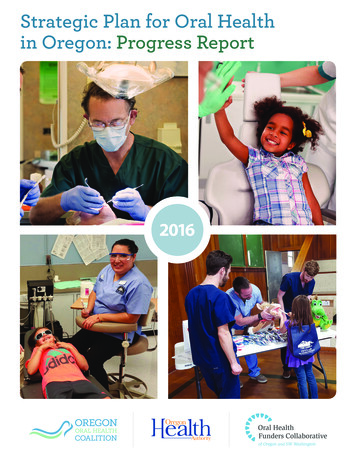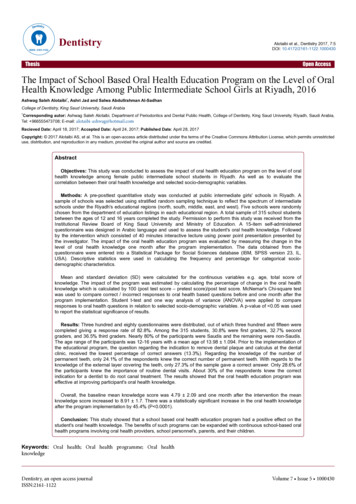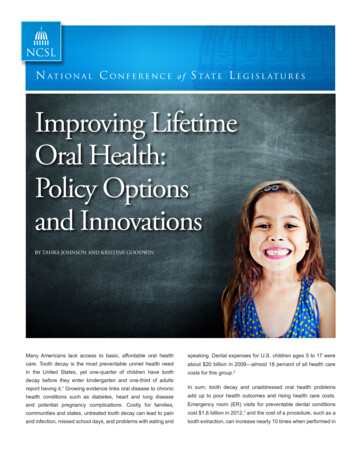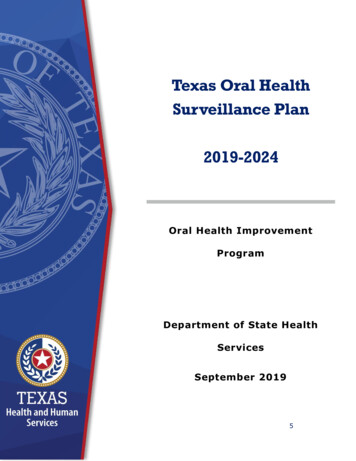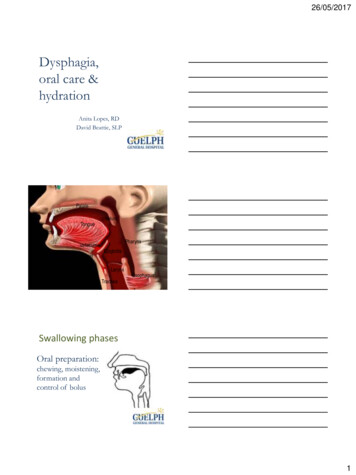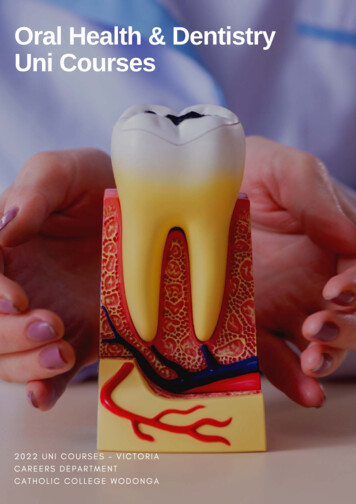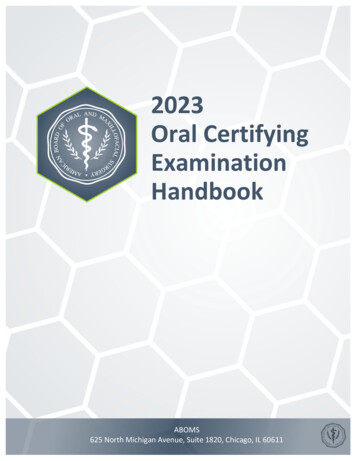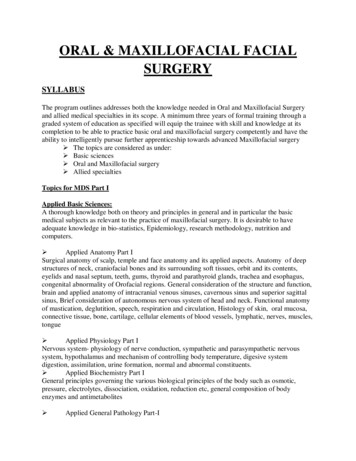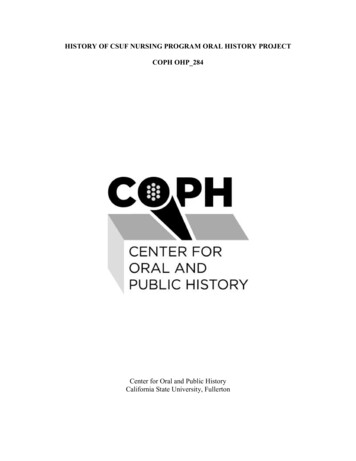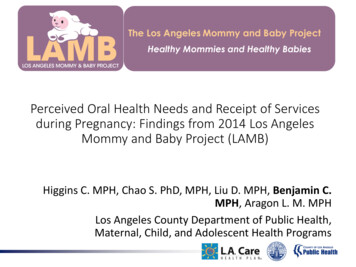
Transcription
The Los Angeles Mommy and Baby ProjectHealthy Mommies and Healthy BabiesPerceived Oral Health Needs and Receipt of Servicesduring Pregnancy: Findings from 2014 Los AngelesMommy and Baby Project (LAMB)Higgins C. MPH, Chao S. PhD, MPH, Liu D. MPH, Benjamin C.MPH, Aragon L. M. MPHLos Angeles County Department of Public Health,Maternal, Child, and Adolescent Health Programs
s and limitationsQuestions
Dental Care and PregnancyPoor oral health in pregnant women has been associatedwith premature births and low birth weight infants.1-3Hormonal changes during pregnancy can increase bacteriain the mouth, and excess stomach acid from morningsickness can break down tooth enamel.4In the US, up to 40% of pregnant women have some form ofperiodontal disease.5
Current recommendationsAccording to the AmericanCongress of Obstetricians andGynecologists, dental X-rays andteeth cleanings are safe forpregnant women.Routine oral health assessments atthe first prenatal visit are advised.
Need for Current ProjectData on the oral health needs of pregnant women and theiraccess to care is lacking in Los Angeles County.Los Angeles County is home to 10 million people. In 2014there were 130,150 live births.Birth certificate data is very limited and delayed.Need local data to help the health department andcommunity partners identify at-risk groups and developprograms/policies.5
PurposeDescribe the prevalence of dental problems duringpregnancy.Assess racial disparities, and factors associatedwith, oral health needs and receipt of care.
MethodsData Source:The Los Angeles Mommy and Baby Project (LAMB) Population based survey of women who have recentlydelivered a live birth Collects information about factors and events that mayinfluence a woman’s pregnancy and birth outcomes
Methods Mixed-mode methodologyfor data collection similar tothe CDC Pregnancy RiskAssessment MonitoringSystem (PRAMS) Project Conducted in four waves LAMB provides a 20Ralphs/Food4Less giftcertificate to everyparticipant who completes atleast 50% of the survey.
MethodsMothers were asked thefollowing questions: “During your most recentpregnancy, did you need tosee a dentist for a problem?” “During your most recentpregnancy, did you go to adentist or dental clinic?”
MethodsMeasures:Outcomes:Report of a dental problemReceipt of dental carePredictors:Mother’s ageMother’s race/ethnicityMedi-Cal before pregnancyInsurance status/type during pregnancyMother’s educationMarital statusDepression during pregnancyHomelessness during pregnancySmoking status during pregnancyEarly PNC
MethodsStatistical Analysis: Descriptive analyses using both sampling and non-responseweights were performed to estimate the populationprevalence of selected factors. Racial disparities and factors associated with seeing a dentistduring pregnancy among those mothers who reportedhaving a dental problem were analyzed using bivariate andmultiple logistic regression techniques. All data analyses were conducted using Statistical AnalysisSoftware (SAS) version 9.3 survey procedures to account forthe complex sampling scheme.
ResultsIn 2014 LAMB mothers,representing 2014 LACmothers, were: 55% Hispanic18% Asian/PI19% White7% African American56% 25-34 years old5% less than 20 years oldNearly 57% had greater thana high school education 17.5% had less than a highschool educationMother's Race/EthnicityLos Angeles Mommy and Baby Survey 201417.6%Latina7.4%African American55.2%Asian/PIMother's EducationLos Angeles Mommy and Baby Survey .0% 12N 6,035White18.5%12 12
Results20% of mothers in Los Angeles County needed to see adentist for a problem during their last pregnancy.Mothers Reporting a Dental Problem During Pregnancy byRace/Ethnicity, Los Angeles County, 0.0%5.0%0.0%Whitep 0.0001HispanicAfrican AmericanAsian/PICounty
Results - BivariateAmong mothers with a dental problem, only 58% saw adentist.Mothers who went to a Dentist by Race/EthnicityLos Angeles Mommy and Baby Survey n p 0.0334HispanicCounty
PredictorResults - Bivariate Mother’s education,marital status, andexperience ofhomelessness duringpregnancy were notsignificant predictors ofreceiving care for a dentalproblem in the bivariateanalyses.Mothers who Saw aDentist % (CL)Mother’s AgeChi-squareP-values0.0029 20 yrs. old43.2 (34.3-52.2)20-24 yrs. old50.3 (40.5-60.1)25-34 yrs. old56.9 (51.4-62.3)35 yrs. old69 (60.5-77.5)Had Medi-Cal beforePregnancy 0.0001Yes50.2 (42.6-57.8)No72.4 (65.5-79.3)PNC Payer Source0.0007Private Insurance70.4 (63.9-76.9)Self Pay60.8 (27.0-94.6)Medi-Cal52.4 (47.2-57.7)Other Govern.40.6 (19.4-61.8)Depression duringPregnancy0.0268Yes51.5 (44.6-58.3)No61 (56.1-66.0)
Results – MultivariateAdjusted Odds RatioWhat are the independent predictors of a mothernot receiving care for a reported an American 20 yrs old3.1620-24 yrs old2.7525-34 yrs oldFinal Model: Modeling the probability of not receiving care including significant factors from thebivariate analysis (Mother’s Age, Mother’s Race/Ethnicity, Insurance during pregnancy (PNC PayerSource), had Medi-Cal before pregnancy, and Depression during pregnancy)Reference Groups: White mothers/mothers 35 16
Results – OverviewBivariate Predictors ofreceipt of careMultivariate Predictorsof receipt of careTarget Groups for PublicHealth InterventionsMother’s AgeMother’s AgeMothers less than 35 yearsoldMother’s Race/EthnicityAfrican American MothersMedi-Cal before pregnancyPNC Payer SourceMother’s Race/EthnicityDepression duringpregnancy17
ConclusionsIn 2014, 20% of mothers needed to see a dentist for aproblem during their pregnancy.Among mothers with a dental problem during pregnancy,only 58% went to a dentist or dental clinic.In multivariate analyses, mother’s race/ethnicity and agewere significant predictors of receiving dental care for aproblem during pregnancy. Public health attention and interventions should focus onhelping mothers less than 35 years of age and AfricanAmerican mothers to access/receive needed dental care duringpregnancy.
Strengths and LimitationsLimitations All information is based on self report and asked 3-7 months after the delivery. Recallbias may present an issue among women and their experiences concerning oral healthbefore and during their pregnancy. Oral health issues, like periodontal disease, can also be asymptomatic, which mayresult in failure to be reported in the survey.Strengths Results are generalizable to women delivering a live infant in Los Angeles County. Sample size is large enough to allow subgroup analyses. High quality data High response rates Surveys printed in English, Spanish, and Chinese Data is very complete with most variables having 1% missing
Funding andAcknowledgementWe would like to thank: All the mothers who participated inthe LAMB Survey The dedicated LAMB project team Our funders First 5 LA, L.A. Care, andMCAH general grants.Data from the 2016 LAMB survey willbe available soon.
ContactFor additional LAMB information please visit:lalamb.ph.lacounty.govAuthor contact information: Chandra Higgins chiggins@ph.lacounty.gov (213)639-6455Presenter contact Information: Christine Benjamin chbenjamin@ph.lacounty.gov (213)639-6456
Questions?Thank you!
References1. Offenbacher S, Katz V, Fertik G, Collins J, Boyd D, Maynor G, et al.Periodontal infection as a possible risk factor for pre-term low birth weight. JPeriodontal 1996;67:1103–13.2. Jeffcoat MK, Geurs NC, Reddy MS, Cliver SP, Goldenberg RL, Hauth JC.Periodontal infection and preterm birth: results of a prospective study. J AmDent Assoc 2001;132:875–80.3. Offenbacher S, Lieff S, Boggess KA, Murtha AP, Madianos PN, ChampagneCM, et al. Maternal periodontitis and prematurity. Part I: Obstetric outcome ofprematurity and growth restriction. Ann Periodontol 2001;6:164–74.4. American College of Nurse-Midwives. Dental Care in Pregnancy. Journal ofMidwifery & Women's Health. 2014;59(1):109-110. doi:10.1111/jmwh.12108.5. Acog.org. Dental X-Rays, Teeth Cleanings Safe During Pregnancy - ACOG.2015. Available at: -Pregnancy.Accessed September 2, 2015.
Tips for Prenatal Care Providers andDental Care WorkersPrograms developed to encourage women to see adentist should target women prior to their childbearing years.Recommend and encourage women to go to adentist or talk to a dental care worker when theyare seen for prenatal visits.
Dental Care and Pregnancy Poor oral health in pregnant women has been associated with premature births and low birth weight infants.1-3 Hormonal changes during pregnancy can increase bacteria in the mouth, and excess stomach acid from morning sickness can break down tooth enamel.4 In the US, up to 40% of pregnant women have some form of
